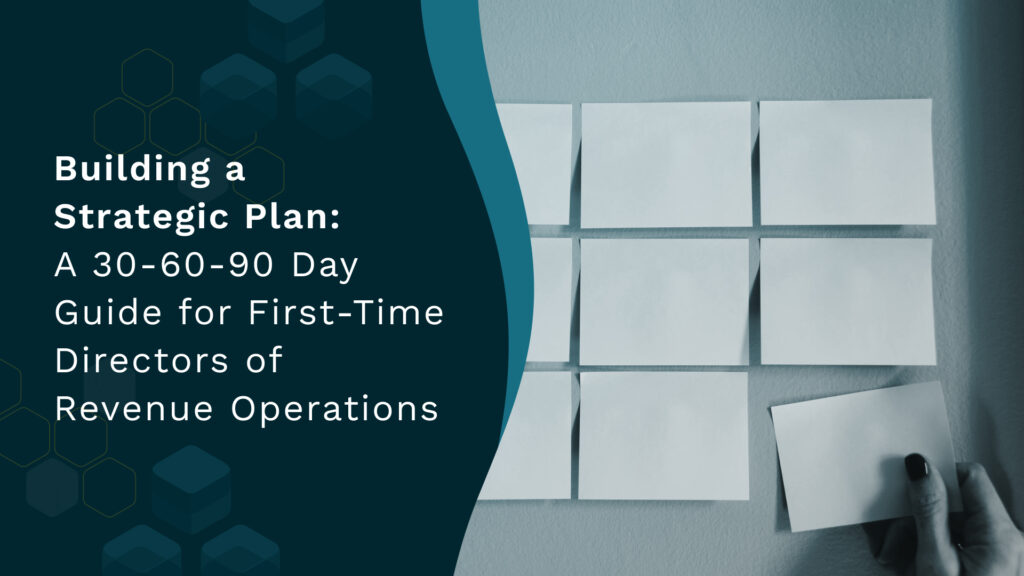
5 Proven Strategies to Reduce Customer Churn
Reducing customer churn is a big goal for revenue leaders in 2024. Here are 5 data-driven strategies to address this concern.
A lot goes into attracting customers, from marketing and sales to onboarding.
Revenue teams invest significant time and resources in:
- Building strategies
- Training, prospecting
- Crafting pitches
- Negotiating contracts.
Yet, customer success and reducing customer churn don’t receive the same rigor.
In today’s business environment, sustainable growth is a primary goal for business leaders. And customer retention builds resilience.
It’s time to make customer success a preemptive and proactive process rather than reacting to churn.
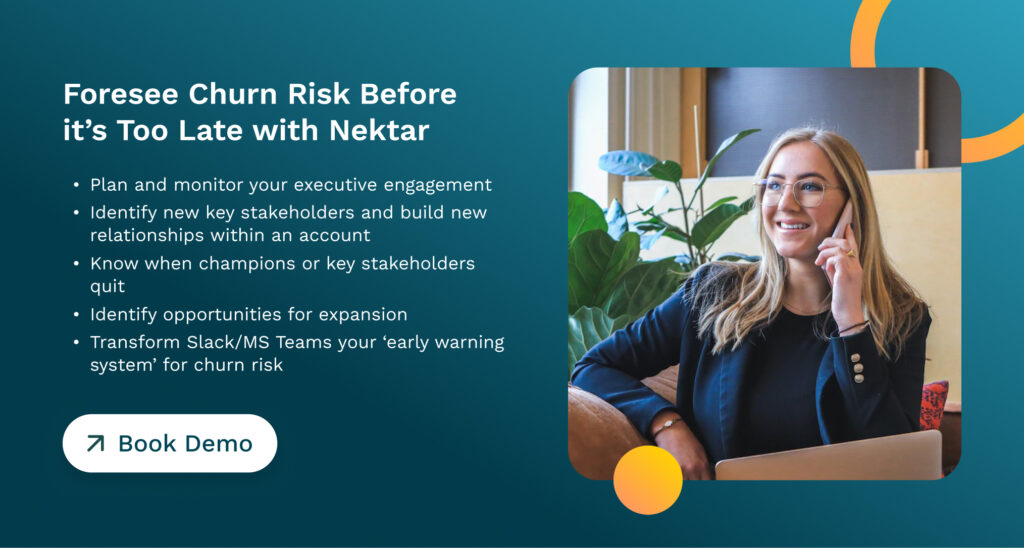
Why Is Reducing Customer Churn Under the Business Microscope?
Churn denotes the percentage of customers who stop your product or service during a specific period.
That’s the opposite of what you, as a company, would like to achieve with your business goals.
Today, profitability depends more on retaining customers than acquiring new ones. You need three new customers to join you to compensate for just one customer.
In an unpredictable economic climate, having customers who stick by you no matter what makes you resilient to change.
Plus, if you deliver high-value experiences to existing clients, they’re 3.5 times more likely to advocate for you.
Loyal customers also bring in additional revenue. They can place, on average, order values that are 67% higher than new customers.
Despite these positive numbers, 64% of organizations expect churn to grow soon. It signals that most revenue leaders still aren’t ready to reduce customer churn.
Source: Lenny’s Newsletter
An uncharacteristically high churn rate can result in:
- Customers moving to competitors, decreasing your market share
- Dissatisfied customers leaving poor reviews, adversely impacting your brand image
- Eroding revenue growth in the long run
That’s why tracking your churn matters.
You need to first understand churn to stop it from negatively affecting your revenue and business growth. And that starts by observing early signs like:
- The customer spending less time on your product than before
- Reduced engagement with customer success teams
- Opting for downgrades in pricing plan
- Change in decision-making stakeholders
- Missed payment schedules
Anticipating churn and understanding it shows you where your strengths and improvement areas lie. It allows you to do something about it before it’s too late.
Data’s Role in Identifying and Reducing Customer Churn
Churn doesn’t happen suddenly. Those clients who are looking to leave may exhibit certain behaviors over the course of their subscription period.
It would help if you had real-time as well as sustained relationship insights to identify these churn indicators.
Clean and reliable data gathered during the post-purchase activity period until renewal gives you these insights.
Data provides vital information about the customer’s journey after purchasing your product (in the form of relationship intelligence).
You must learn to read the right churn signals to develop countermeasures. So, you proactively build strategies to reduce customer churn instead of reacting to it.
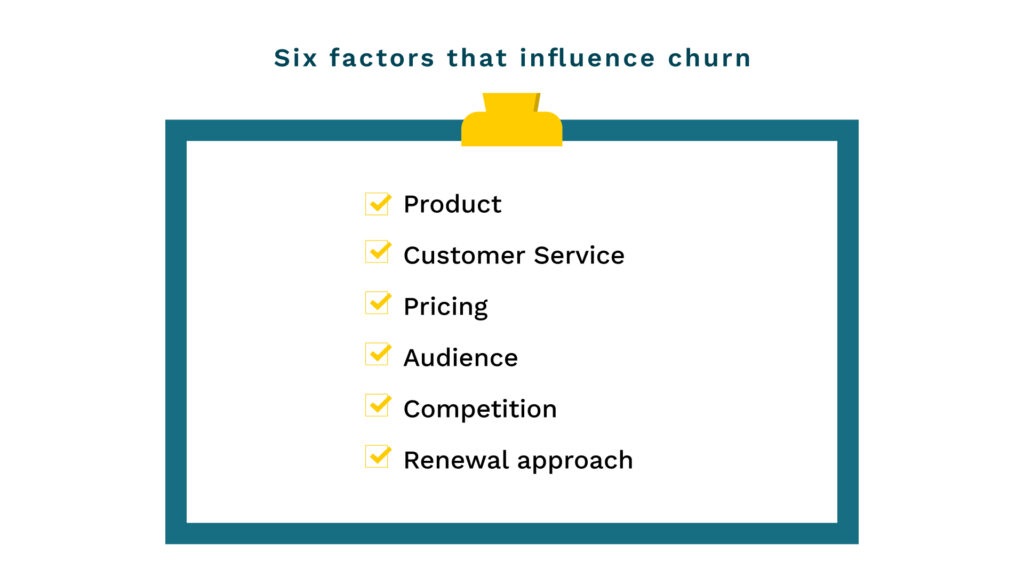
Primarily, shortcomings in these six factors that influence churn:
- Product
- Customer Service
- Pricing
- Audience
- Competition
- Renewal approach
Data gives you a granular understanding of these factors, including customer behavior, preferences, and interactions.
It can guide product onboarding, too. CSMs can encourage product adoption among new customers and track their usage over time.
Plus, with regular check-ins, the customer success teams get an insider’s view into the renewal committee. They can use this information to build a more resilient relationship with customers.
Data also supports streamlined renewal management. You can identify and nurture multiple champions in each account.
Most importantly, data drives the day-to-day service handling. CSMs use insights to respond to customer queries quickly, track complaints, and monitor customer interactions to find the main reasons for churn.
With so much importance attached to data, multiple ways exist to reduce customer churn.
5 Strategies to Leverage Data for Reducing Customer Churn
Customer turnover is unstoppable. However, there are ways in which you can use data to reduce customer churn for sustainable business growth.
Let’s find out how.
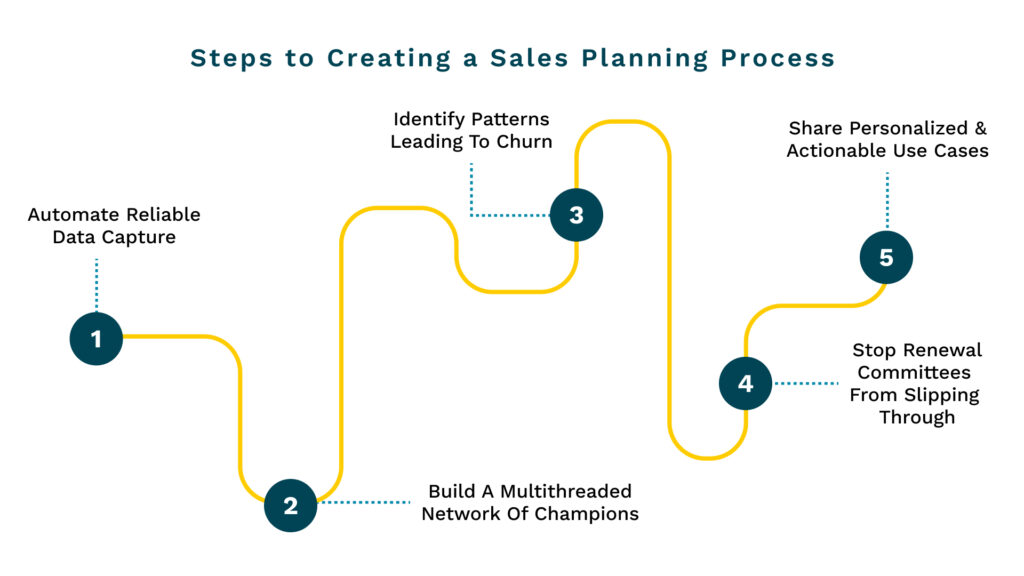
1. Automate reliable data capture
Clean data equals accurate insights.
It’s critical to understand your customers and solve their pain points.
Even though data is so important, several companies still handle at least some parts of the capturing task manually.
The resulting process is time-consuming. It’s a distraction for CSMs from their core responsibilities.
If that isn’t enough, manual data capture is also inconsistent and prone to errors. It eventually leads to lower productivity and higher costs.
Critical data points lay in silos, remaining unstructured and lost.
You can’t mine this data for insights. Nor can you scale as the business grows, accumulating tech and data debt as you go.
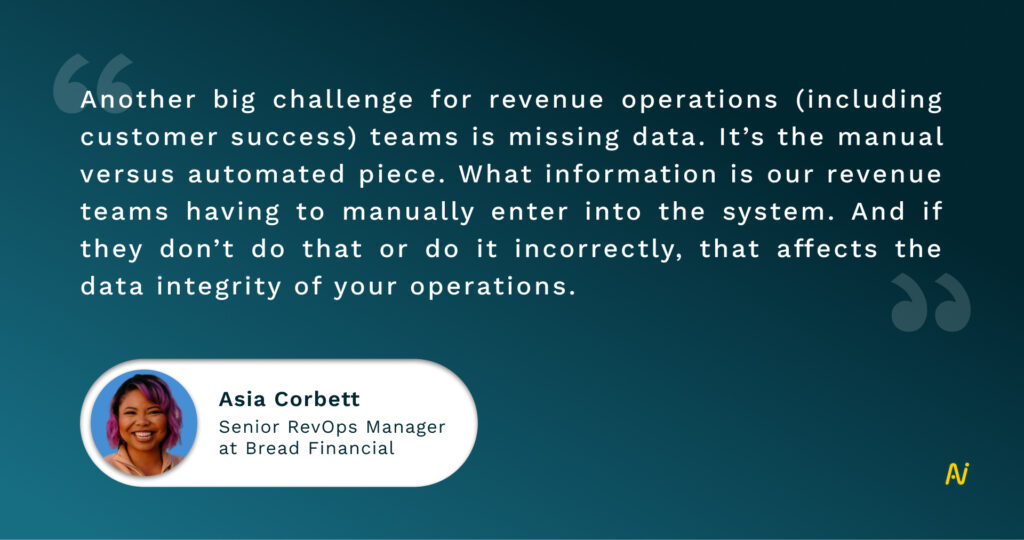
It’s safe to say manual data capture is no longer an efficient process.
Automated data capture, on the other hand, streamlines quality by:
- Reducing manual intervention
- Mitigating data risk
- Saving time for more valuable activities
- Improving scalability
You can automatically gather data on contact and account activities (including names and roles in the renewal committee). Complete and reliable data increases the potential to reduce customer churn.
You can collect this from multiple sources—email, virtual meetings, virtual messaging (like Slack), calendar, notes, and even social media.
Automated data capture provides a 360-degree view of customer interactions across these channels. So, you never miss a crucial stakeholder contact, activity, or opportunity.
Accurate, reliable, and consistent data aligns product onboarding with customer needs.
CSMs know each account’s preferences and cater to the correct use cases from the get-go.
By segmenting renewal committees, you can match the right CSMs with the accounts they can serve best, per their capabilities.
Automated data capture enables you to continue adding new data and contacts to each renewal committee. With this updated information, your teams can continue buyer persona development as the relationship progresses.
2. Build a multithreaded network of champions
If CSMs genuinely want to succeed at reducing customer churn, it’s best to build targeted engagement with the entire renewal committee.
That’s because buying and deployment aren’t solo acts. A buyer committee, having anywhere between 5 and 20 members, is part of the process.
Customer engagement becomes more challenging when the stakeholders during sales and execution can be different.
For instance, the finance and IT teams may be active stakeholders during sales. However, the marketing POC is added later to the committee. And they’re in charge of deploying your product.
Another reason could be that a few stakeholders shift jobs before the renewal is due. If your CSM has only connected with the champion or executive sponsor, their absence may cause friction. Identifying an alternate advocate and then building trust may take several months.
In the meantime, the renewal could be due. A distorted relationship could hamper the chances of the client sticking with you. The alternate champion may switch to their preferred solution and drop you instead.
Reduce customer churn or avoid it with data by spotting single-threaded accounts early.
Use these insights to switch tactics to multithreading.
Automated data capture can help you build account maps and monitor the executive sponsor’s movement.
You can also determine if CSMs actively engage with existing and new stakeholders in the renewal committee.
As customer success improves interactions with the entire committee, they may discover previously hidden pain points.
This could be valuable information for expansion.
CSMs can suggest relevant features or product upgrades to solve these new pain points. They can leverage the relationship with champions to push upsell and cross-sell opportunities forward.
Highly engaged renewal committees lead to lower chances of them leaving.
3. Identify patterns leading to churn
Churn is inevitable. Stopping it may be insurmountable, but reducing customer churn is achievable.
It starts with anticipating churn.
The first step in churn prediction is analyzing the causes behind it. You can do this by tracking product usage for early signs.
Next, you can identify KPIs or metrics and engagement traits influencing churn.
These may include:
- A drop in product usage
- Reduced logins
- Lower referral activity than before
- Increase in complaints for a particular account or certain features
- A longer period between product updates
- Reduced visits to the website (specifically the resources page)
Another method for predicting churn is to monitor executive engagement throughout the customer journey.
Scan their participation during important events such as QBRs and track their meeting cadence.
If a champion or an executive sponsor misses these key events, it may be an early indicator of churn. Their presence in the following meeting means your engagement is on track.
However, if they miss a series of events, it could be a cause for concern.
More robust engagement also provides easy access to key stakeholders. You can influence them when the existing champion leaves, or you plan to expand their account.
Previously captured churn data assists with anticipating at-risk accounts.
It can inform the next steps for strategic clients using predictive analytics. Some helpful data points to remember are evolving customer preferences, demographics, transaction history, and renewal committee sentiments.
While the above information is internally available, don’t miss out on a few external factors like:
- Market changes
- Economic changes
- Organizational changes
- Competitor products
- New entrants in your market
Google Analytics and Adobe Analytics are some of the most preferred tools to study external data points.
Customers communicate through emails, calls, virtual meetings, virtual messaging, meeting notes, and feedback. Therefore, it only makes sense to monitor them for renewal committee interactions.
This data can turn up insights on winning patterns and how you can replicate them to reduce customer churn.
4. Stop renewal committees from slipping through
When you prioritize data, you can seamlessly onboard clients with all their information readily accessible. It’s one of the first correct steps in reducing customer churn.
That’s because the introduction to the product sets the tone for the rest of the relationship.
Communicating consistently throughout their customer success journey (from onboarding to renewal) is essential.
You can share the most relevant onboarding resources if you know what your customers need help with. These could be case studies, resource learning centers, product guides, community forums, or FAQs.
You proactively reach out to clients. CSMs can share hints, tips, and additional information on features before the customer asks. It encourages them to explore your product further.
You can also set up instant alerts when a champion leaves the renewal committee.
It helps you quickly turn churn into opportunity by touching base with the backup champions.
Not just that. You can also follow the previous champion’s movement for targeting expansion. If they move to another customer account, you can reconnect with them and enrich that relationship.
You can pass their insights to sales if the champion moves to a target account.
Data also lets you prioritize the right accounts (at risk and most valuable) and stakeholders. Customer success teams leverage leading indicators like health scores, multithreading scores, and relationship alerts.
You can also manage renewals better by ensuring they happen seamlessly.
To improve the customer experience, you could offer changes in the subscription or service. Or you may provide flexibility for payments. These purposeful gestures foster loyalty.
Plus, they help CSMs avoid unintentional churn through failed payments, missed renewal dates, or delayed payments.
You can send renewal intimations much in advance. And notify them of changes to the product, pricing, payment, or the CSM in advance.
So, instead of rushing the client through the process (acting as vendors), CSMs can guide clients (working as strategic partners).
You can expand the account as you guide the renewal committee to the next subscription period.
For example, you may convert a trial customer to a paid one. Or encourage them to add features and upgrades.
When you start treating the renewal process as strategic, it becomes easier to identify significant friction points and make the necessary improvements.
5. Share personalized and actionable use cases
The most effective way to leverage data for reducing customer churn is:
- To drive personalization for clients and
- Encourage continued usage of your product.
Use insights from the CRM and adjacent tools across the customer journey. And deploy them for a customized onboarding experience tailored to each client and their needs.
Identify specific needs and pain points to offer resources and guidance. This helps you educate them on how to make the most of your solution.
Tailored insights also help define a personalized roadmap for each account.
It makes navigating the product more accessible. Plus, it shows the customer exactly how your solution matches their business goals.
Historical data is beneficial in digging into customer success stories. You can then share these stories with customers in the same industry or those with a similar business model.
These personalized insights can transform into suggestions of highly relevant use cases, services, or features.
Not only do the use cases assist the entire renewal committee but also individual stakeholders.
At the renewal stage, they help convince individual stakeholders of your value at the collective renewal committee and personal level.
It also shows you which offers or feature upgrades are the most relevant for unsolved pain points.
Continued education improves the quality of engagement for customers.
It acts as a constant reminder of the effectiveness of your solution. And encourages users to make your product a part of their daily work.
Real-time account data can help you adapt and scale your solution to grow with the client’s business.
Customers invest more in you when you offer innovation that boosts their growth and validates the product purchase decision. You can observe a 30% lift in high-quality deals when you hold value-affirming customer interactions.
The higher the usage, the lower the churn. Empowered customers are more likely to stay.
Go Beyond Traditional Tools To Reduce Customer Churn
Organizations that do well at leveraging clean data also improve their profitability.
It involves moving beyond traditional methods. It could be avoiding complete reliance on the CRM for insights or running ineffective customer surveys.
These methods don’t always have the critical capabilities like:
- Journey mapping
- Account mapping
- Personalized and real-time recommendations
In addition to that, they may not be scalable.
A powerful AI tool dives headfirst into contact and activity-level data. It uses clean data to bring up reliable insights for reducing customer churn.
With AI-led automation, Nektar’s in-depth unified activity capture solution:
- Collects reliable data and continually enriches it to build an accurate account map.
- Provides complete information on the renewal committee to strengthen your multithreading efforts.
- Shares real-time alerts on early signs of churn like champion movement and executive engagement.
- Supplies actionable data for personalizing the customer journey.
- Makes onboarding and renewal seamless, with in-depth insights on relevant use cases.
- Encourages expansion with upsell and cross-sell opportunity alerts.

PUBLISHED BY
